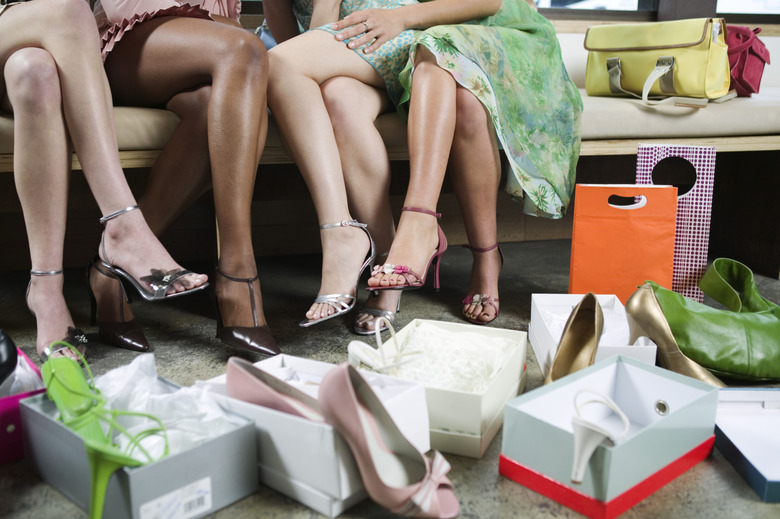How To Make The Phases Of The Moon Using A Shoebox
As the moon orbits around Earth, parts of the moon reflect sunlight. In the night sky, we observe these moon phases from our different locations on Earth. Because the moon changes from new, to full, to quarter each month, the morphing moon often inspires the curious onlooker to discover the moon's traits and connections to where we are on Earth. To create moon phases, you can simulate space in a shoebox to show how the sun and moon interact to create moon shapes.
Step 1
Find a shoebox and shoebox lid. Open the shoebox. Cut a large swath of black construction paper. Glue the construction paper to coat the inside of the box. Be sure to cover all corners, the lid top, sides, and the bottom of the box with black paper.
Step 2
Take out the spool or long piece of black thread. Snip a piece of the black thread to about 2 cm long. Tape or glue the ball to one end of the thread. Tape or glue the other end of the thread to the center of the inside of the box lid. The ball, hanging from the end of the thread, should hang like a disco ball from the center of the lid into about the middle of the shoebox.
Step 3
Grab your flashlight. Hold the bulb-end of the flashlight flush against one short outside end of the shoebox. With the flashlight flat against the cardboard, use your pencil to trace a circle the size of the flashlight against the box. Put the flashlight down. Using the scissors carefully cut out the traced circle.
Step 4
With the long end of the shoebox facing you, punch a hole about an inch in from the left side and then punch a hole about an inch in from the right side. Turn the box so the other long side is facing you and repeat, giving you a total of four holes punched.
Step 5
Turn the box so the flashlight hole is facing you. Punch one small hole about 2 inches below and a little to the right of the cut-out flashlight hole.
Step 6
Number each hole. With the box facing you lengthwise, with the flashlight hole on the right side, number the holes 1-5 starting with the No. 1 hole on the left of the long edge of the box. Continue around the box counterclockwise so that the small hole under the flashlight cut-out is hole No. 3.
Step 7
Steady the flashlight. With masking tape or modeling clay, fasten the turned-off flashlight facing into the box through the flashlight hole. Be sure that no other cracks or cuts let in any light. If any light from the room or outdoors does show through, cover the gap with tape.
Step 8
Turn on the flashlight. Peer through each small hole. These holes simulate the moon phases. Mark your observations in a notebook. Note qualities of light and shadow.
Step 9
Draw the moon phases you observe. Also, if you notice any flaws in your box construction, fix with tape, glue or by adding more black paper to keep the box dark inside.
Things Needed
- Shoebox
- Black construction paper
- Glue
- Scissors
- Masking tape
- Modeling clay (Optional)
- Flashlight
- Pencil
- A small black colored ball (ping-pong ball, Styrofoam™ ball (5 cm), black golf ball etc.)
- Black thread (minimum of 5 centimeters)
- Hole puncher
- Notebook
TL;DR (Too Long; Didn't Read)
Pointing a flashlight inside the shoebox simulates sunlight, the small ball hanging from the inside of the lid represents the moon and the series of small holes around the box simulate your observation of the moon from different locations on Earth.
Warning
Be careful when using scissors.
Cite This Article
MLA
Carver, Noelle. "How To Make The Phases Of The Moon Using A Shoebox" sciencing.com, https://www.sciencing.com/make-phases-moon-using-shoebox-5761277/. 24 April 2017.
APA
Carver, Noelle. (2017, April 24). How To Make The Phases Of The Moon Using A Shoebox. sciencing.com. Retrieved from https://www.sciencing.com/make-phases-moon-using-shoebox-5761277/
Chicago
Carver, Noelle. How To Make The Phases Of The Moon Using A Shoebox last modified March 24, 2022. https://www.sciencing.com/make-phases-moon-using-shoebox-5761277/
